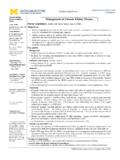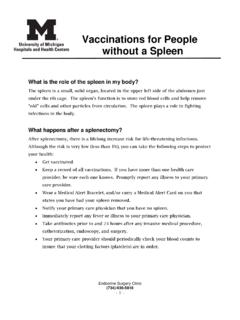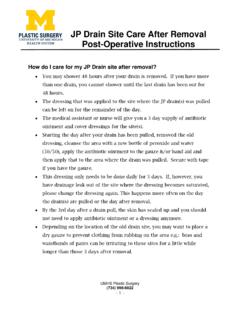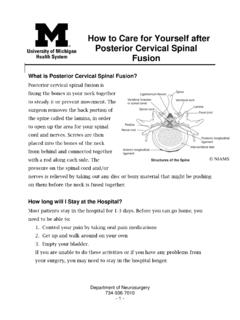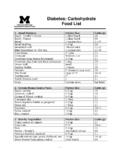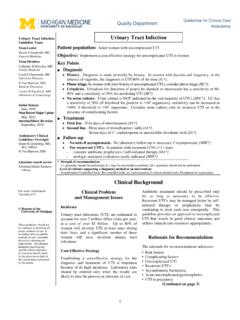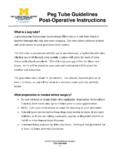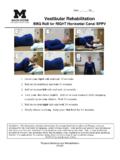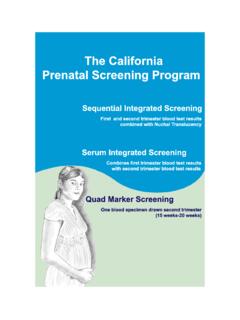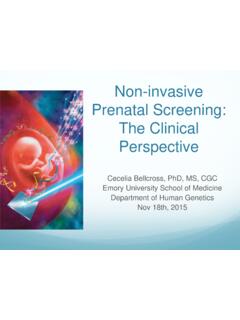Transcription of Prenatal Care Guideline Prenatal Care - Michigan Medicine
1 Guidelines for Clinical Care Quality Department Ambulatory Prenatal Care Guideline Prenatal Care Team Team Leader Patient population: Women of childbearing age, pregnant women, and their fetuses. Mark C. Chames, MD. Obstetrics / Gynecology Objectives: (1) Promote maternal and infant health. (2) Reduce maternal mortality and morbidity and fetal loss. Team Members (3) Reduce preterm birth, intrauterine growth restriction, congenital anomalies, and Joanne M. Bailey, CNM, failure to thrive. PhD. Obstetrics / Gynecology Key Points: Grant M. Greenberg, MD, Prenatal care summary. Table 1 summarizes the main aspects of Prenatal care from preconception MA, MHSA through delivery (history and examination; testing and treatment; education and planning). Family Medicine Fetal surveillance. Table 2 shows the common indications for antepartum fetal surveillance with R. Van Harrison, PhD nonstress testing and amniotic fluid index (AFI), the gestational ages at which to initiate testing, and Medical Education the frequency of testing.
2 Jocelyn H. Schiller, MD. Pediatrics Referral. Table 3 summarizes the indications for referral. Important care aspects: Consultant Assess risk factors. For all women, perform a history and physical that includes a risk assessment with a Christa B. Williams, MD. Family Medicine goal of identifying risk factors for adverse pregnancy outcome [I-D]. Review the patient's medical history and any prior pregnancy and delivery records. Clearly document risk factors and add them to the patient's problem list. Initial Release -Screen for tuberculosis in pregnant women at high risk for TB. December 2013. Interim/Minor Revision -Refer hepatitis B carriers to hepatology due to their long term risk for cancer and cirrhosis. October 2015 -Screen all patients for depression during the third trimester. January 2019. -Provide contraceptive counseling during the third trimester teaching. -Review future chronic disease risks with patients during pregnancy and at the postpartum visit.
3 UMHS Guidelines Progesterone therapy. Progesterone should be offered to patients who have a history of prior spontaneous Oversight Team preterm birth or who are found to have a shortened cervix on ultrasound [I-A]. Karl T. Rew, MD. R. Van Harrison, PhD STI testing. Test all women for sexually transmitted infections, including HIV. Patients at risk for STIs during pregnancy should be retested in the third trimester [I-A]. Estimated date of delivery (EDD). Establish a patient's EDD prior to 20 weeks, with consideration given Literature search service to menstrual history, mode of conception, and sonographic findings using standardized criteria (see Taubman Health Sciences Library page 14) [I-C]. Tdap vaccination. Offer Tdap vaccination to all women. Administering Tdap at 27-36 weeks facilitates passive pertussis immunization of newborns [I-D], and administering it around 32 weeks may For more information: 734-936-9771 optimize maternal antibody formation peaking at normal time of delivery.
4 No non-medically-indicated delivery < 39 weeks. Non-medically-indicated planned delivery before 39. weeks' gestation is contraindicated [III-B]. der/clinical-care-guidelines * Strength of recommendation: I = generally should be performed; II = may be reasonable to perform; III = generally should not be performed. Regents of the Level of evidence supporting a diagnostic method or an intervention: University of Michigan A = randomized controlled trials; B = controlled trials, no randomization; C = observational trials; D = opinion of expert panel Clinical Background These guidelines should not be construed as including all proper Management Issues methods of care or excluding other acceptable methods of care reasonably directed to obtaining Women who receive Prenatal care during the first (1) Early and continuing risk assessment the same results. The ultimate trimester have better pregnancy outcomes than (2) Health promotion judgment regarding any specific women who have little or no Prenatal care.
5 Expert (3) Medical and psychosocial interventions and clinical procedure or treatment must be made by the physician in panels on the content of Prenatal care have follow-up light of the circumstances identified the following three basic components: Each of these three components is reflected in this presented by the patient. Guideline . (Continued on page 5). 1. Table 1. Guidelines for Prenatal Care*. Gestational Age History and Examination Testing and Treatment Education and Planning Preconception Medical history including menstrual, Blood type and Antibody Screen Counsel on significant positive - 12 weeks sexual, immunization, infectious Hemoglobin / Hematocrit / Platelet findings elicited by history, exposure and risk count physical, or test results Obstetrical history Rubella titer (vaccinate before Review test results if available Family and genetic history conception ) Review dating criteria.
6 Psychosocial history including Hepatitis B Surface Antigen Screen for aneuploidy tobacco, alcohol, drugs, HIV Discuss: employment, and nutrition STI screening (Gonorrhea, -Nutrition in pregnancy (including Depression screen Chlamydia, Syphilis) recommendations for folate and Intimate partner violence (IPV) Urine culture at first Prenatal visit calcium, and cautions regarding screen Cervical cancer screening mercury in fish and pathogens in Current pregnancy symptoms Cystic fibrosis (CF) carrier uncooked or unpasteurized foods). Complete physical exam including screening -Weight gain in pregnancy height, weight, BMI, blood Screening for spinal muscular -Work related exposures or risks pressure, and pelvic examination atrophy (SMA) -Recent or planned travel with Hemoglobin electrophoresis regard to Zika and other infectious Other genetic screening (Tay- disease risks or exposures Sachs, etc.)
7 -Breastfeeding Diabetes testing -VBAC/TOLAC . Varicella titer (vaccinate before Provide obesity counseling . conception) Refer for genetic counseling . Hepatitis C testing Refer to a high-risk provider . Tuberculosis testing . Aneuploidy screening . Influenza vaccination . 12-16 weeks Current pregnancy symptoms Aneuploidy screen Review test results Interim medical, psychosocial, and Diabetes screening at 12 weeks Discuss: nutritional evaluation Influenza vaccination -Physical changes Weight and blood pressure -Safe sex and sexuality during Fetal heart rate pregnancy -Exercise and fitness during pregnancy -Managing work during pregnancy -Seatbelt use in pregnancy 16-22 weeks Current pregnancy symptoms Ultrasound Review test results Interim medical, psychosocial, and Progesterone for prevention of Review dating criteria nutritional evaluation recurrent preterm birth Discuss Weight and blood pressure Influenza vaccination -Signs of complications, including Fetal assessment including fetal heart preterm labor and preeclampsia rate and growth -Childbirth classes -Common discomforts in pregnancy -Emotional changes in pregnancy -Trauma protocol in pregnancy Provide directions to the Birth Center 2 UMHS Prenatal Care Guideline , September 2018.
8 Table 1. Guidelines for Prenatal Care* (Continued). Gestational Age History and Examination Testing and Treatment Planning and Education 22-28 weeks Current pregnancy symptoms Diabetes screening at 24-28 weeks Review test results Interim medical, psychosocial, and Hemoglobin / Hematocrit / Platelet Discuss: nutritional evaluation count at 24-28 weeks -Signs of complications including Weight and blood pressure Antibody Screen at 24-28 weeks in preterm labor and preeclampsia Fetal assessment including fetal heart Rh negative women -Parenting, infant classes rate and growth Influenza vaccination -Breastfeeding classes -Contraception and family planning -Family adjustment -Work plans -Diet and nutrition in pregnancy -VBAC/TOLAC . 28-34 weeks Current pregnancy symptoms Tdap vaccination at 27-36 weeks Review test results Interim medical, psychosocial, and RhoD Immune Globulin (Rhogam) Discuss fetal movement monitoring nutritional evaluation given at 28-29 weeks in Rh Provide anticipatory guidance Depression screen negative women regarding labor and delivery IPV screen Influenza vaccination Discuss contraception and family Weight and blood pressure Nonstress testing after 32 weeks planning Fetal assessment including fetal heart Identify a newborn care provider rate and growth Provide car seat information 34-38 weeks Current pregnancy symptoms Anogenital culture for Group B Review test results Interim medical, psychosocial, and Streptococcus (GBS) at 35-37 Review signs of labor nutritional evaluation weeks (unless already GBS Discuss.)
9 Weight and blood pressure positive in urine during current -Infant safety after birth Fetal assessment including fetal heart pregnancy or prior history of a -Caring for self and infant after rate, growth, and lie (use of GBS-affected infant) delivery ultrasound to document lie is Nonstress testing -Parenting issues including return indicated if uncertain by Leopold's HIV and STI screening to work, breastmilk collection and maneuvers or sterile vaginal exam) (Gonorrhea, Chlamydia, storage, childcare Syphilis) repeated in high-risk patients . Acyclovir for women with HSV . Influenza vaccination . 38 weeks - Current pregnancy symptoms Offer membrane sweeping Review test results delivery Interim medical, psychosocial, and Delivery by 41-42 weeks (elective Review dating criteria nutritional evaluation delivery prior to 39 weeks is Review signs of labor Weight and blood pressure contraindicated).
10 Fetal assessment including fetal heart Nonstress testing . rate, growth, and lie Influenza vaccination . Postpartum Blood pressure Influenza vaccination Discuss: visit (at 4 Depression screen MMR and varicella vaccinations -Contraceptive initiation to 8 weeks) IPV screen Cervical cancer screening -Future pregnancy planning . Breastfeeding Diabetes test -Future chronic disease risk . Bleeding -Healthy lifestyle Laceration healing Pelvic floor recovery * The items listed comprise a broad list of general topics to be covered, and may be based on evidence of varying quality, including expert opinion. Some topics may not be relevant for some individuals, while some clinical scenarios may prompt additional evaluation or education that is not listed here. Emphasize items that are most relevant for your patient. These items should be performed when indicated by the clinical scenario. 3 UMHS Prenatal Care Guideline , September 2018.
